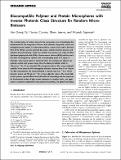Files in this item
Biocompatible polymer and protein microspheres with inverse photonic glass structure for random micro-biolasers
Item metadata
| dc.contributor.author | Ta, Van Duong | |
| dc.contributor.author | Caixeiro, Soraya | |
| dc.contributor.author | Saxena, Dhruv | |
| dc.contributor.author | Sapienza, Riccardo | |
| dc.date.accessioned | 2021-07-07T16:30:12Z | |
| dc.date.available | 2021-07-07T16:30:12Z | |
| dc.date.issued | 2021-06-25 | |
| dc.identifier | 274801587 | |
| dc.identifier | 14d8d097-3870-485f-a894-8ae8183744ee | |
| dc.identifier.citation | Ta , V D , Caixeiro , S , Saxena , D & Sapienza , R 2021 , ' Biocompatible polymer and protein microspheres with inverse photonic glass structure for random micro-biolasers ' , Advanced Photonics Research , vol. Early View , 2100036 . https://doi.org/10.1002/adpr.202100036 | en |
| dc.identifier.issn | 2699-9293 | |
| dc.identifier.other | RIS: urn:1C63BC5AE1FA5AFB6479DE49F8DAF172 | |
| dc.identifier.other | ORCID: /0000-0003-4605-957X/work/96141552 | |
| dc.identifier.uri | https://hdl.handle.net/10023/23490 | |
| dc.description | This research was funded by Vietnam National Foundation for Science and Technology Development (NAFOSTED) under grant number 103.03-2017.318 and the the EPSRC Standard Grant EP/T027258/1. | en |
| dc.description.abstract | The miniaturization of random lasers to the micrometer scale is challenging but fundamental for the integration of lasers with photonic integrated circuits and biological tissues. Herein, it is demonstrated that random lasers with a diameter from 30 to 160 μm can be achieved by using a simple emulsion process and selective chemical etching. These tiny random laser sources are made of either dye-doped polyvinyl alcohol (PVA) or bovine serum albumin (BSA) and they are in the form of microporous spheres with monodisperse pores of 1.28 μm in diameter. Clear lasing action is observed when the microporous spheres are optically excited with powers larger than the lasing threshold, which is 154 μJ mm−2 for a 75 μm diameter PVA microporous sphere. The lasing wavelength redshifts 10 nm when the PVA microsphere diameter increases from 34 to 160 μm. For BSA microspheres, the lasing threshold is around 55 μJ mm−2 for a 70 μm diameter sphere and 104 μJ mm−2 for a 35 μm diameter sphere. The simple fabrication process reported allows for detail studies of morphology and size, important for fundamental studies of light–matter interaction in complex media, and applications in photonic integrated circuits, photonic barcoding, and optical biosensing. | |
| dc.format.extent | 7 | |
| dc.format.extent | 3315952 | |
| dc.language.iso | eng | |
| dc.relation.ispartof | Advanced Photonics Research | en |
| dc.subject | Bovine serum albumin | en |
| dc.subject | Inverse photonic glass structures | en |
| dc.subject | Microlasers | en |
| dc.subject | Polyvinyl alcohol | en |
| dc.subject | Random lasing | en |
| dc.subject | QC Physics | en |
| dc.subject | QH301 Biology | en |
| dc.subject | DAS | en |
| dc.subject.lcc | QC | en |
| dc.subject.lcc | QH301 | en |
| dc.title | Biocompatible polymer and protein microspheres with inverse photonic glass structure for random micro-biolasers | en |
| dc.type | Journal article | en |
| dc.contributor.institution | University of St Andrews. School of Physics and Astronomy | en |
| dc.identifier.doi | 10.1002/adpr.202100036 | |
| dc.description.status | Peer reviewed | en |
This item appears in the following Collection(s)
Items in the St Andrews Research Repository are protected by copyright, with all rights reserved, unless otherwise indicated.

